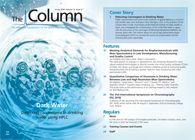Thermo Fisher Scientific Awards Tandem Mass Tag Grant
The winners of the 2016 Thermo Scientific Tandem Mass Tag (TMT) Research Award were celebrated at a ceremony held at the 64th American Society of Mass Spectrometry (ASMS) Conference on Mass Spectrometry and Allied Topics in San Antonio, Texas, USA.
The winners of the 2016 Thermo Scientific Tandem Mass Tag (TMT) Research Award were celebrated at a ceremony held at the 64th American Society of Mass Spectrometry (ASMS) Conference on Mass Spectrometry and Allied Topics in San Antonio, Texas, USA.
Now in its second year, the award recognizes scientists based on the innovation and potential impact of their work in the field of proteomics. Winners received awards of TMT and other mass spectrometry-related reagents, valued at $10,000, $7500, and $5000.
Noah Dephoure, Weill Cornell Medical College, New York, USA, was the “Gold Level” Recipient. His laboratory develops and refines proteomics tools, and uses them to study signalling events that underlie basic cellular biology and human disease. “In my laboratory, we are using TMT to define the molecular mechanisms of tumor metastasis,” said Dephoure.
Recipient of the “Silver Level” award was Domitillie Schvartz, University of Geneva, Geneva, Switzerland. Her research group has investigated diagnostic and prognostic biomarkers of brain injuries using proteomic approaches on body fluids. Her own research has applied “omic” approaches towards type 2 diabetes.
Sina Ghaemmaghami, University of Rochester, Rochester, USA, received the “Bronze Level” award for his research on understanding the mechanisms of cellular protein folding and degradation with a special focus on neurodegenerative disorders.
Speaking on behalf of Thermo Fisher Scientific Monica O’Hara-Noonan, Market Development Manager, Protein Biology Bioscience, said, “We are delighted to offer the TMT Research Grant Award again this year. The number and quality of the applications increased substantially from our inaugural year, and we look forward to seeing what these talented scientists achieve with our latest instrumentation and reagents. The range and diversity of the submissions we received have provided us with an exciting glimpse into what’s next for proteomics.”
Applications for the 3rd annual Tandem Mass Tag Research Award open on 18 September 2016. - L.B.
For more information please visit www.thermofisher.com/TMTGrant

Analysis of PFAS in Milk by LC-MS/MS
May 15th 2025Dairy milk is one commodity that can be impacted by environmental contaminants, such as PFAS, so it is important to implement extensive, robust, and accurate testing. In this work, a sensitive and reliable method was developed for the analysis of PFAS in milk by LC-MS/MS at levels as low as 0.01 µg/kg.

.png&w=3840&q=75)

.png&w=3840&q=75)



.png&w=3840&q=75)



.png&w=3840&q=75)










